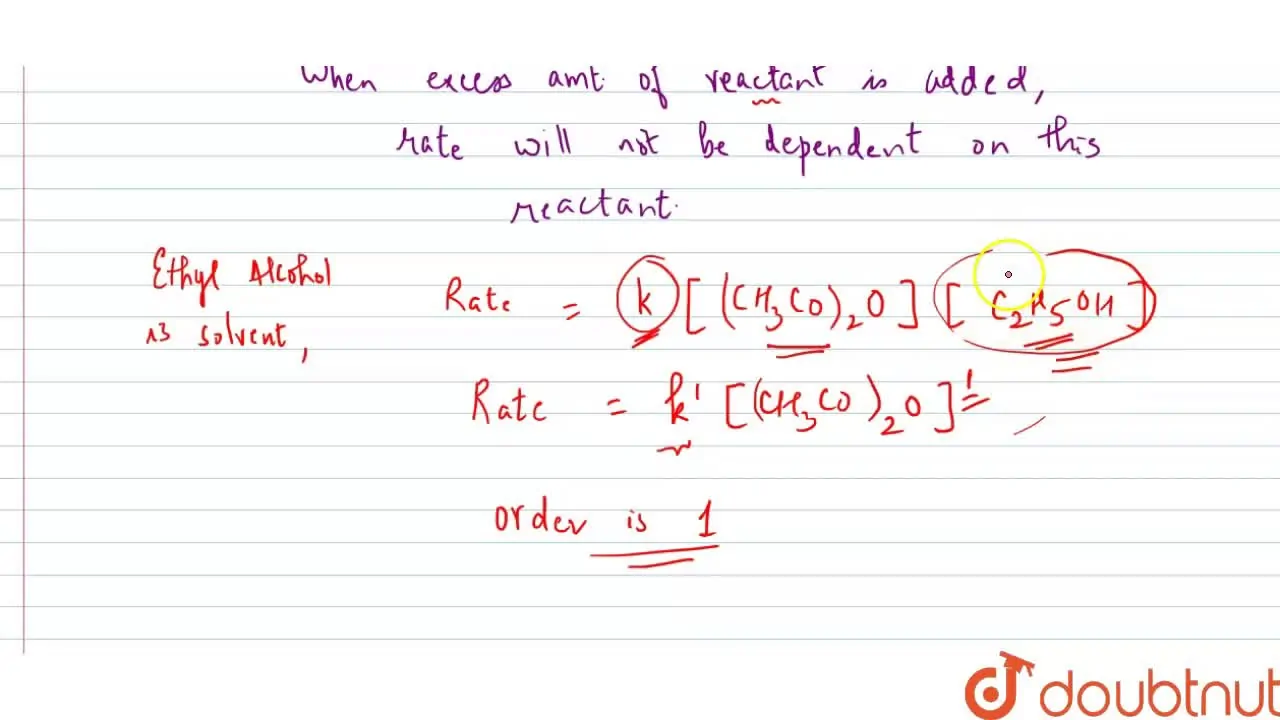The esterification of acetic anhydride by ethyl alcohol can be represented by the following balanced equation:
(CH3CO)2OA+C2H5OHB→CH3COOC2H5+CH3COOH
When the reaction is carried out in dilute hexane solution, the rate may be represented by k[a][b]. When ethyl alcohol (B) is the solvent, the rate may be represented by k[A] the values of k are not the same in the two cases). Explain the difference in the apparent order of the reaction.
When a solvent is also a reactant, its concentration is so large compared with the extent of reaction that it does bot change. (Compare the convention we used, in studying the thermofynamics of aqueous solutions, of viewing water as always being in its standard state in all dilute solutions). Thus, the dependence of the rate on the concentration of ethyl alcohol cannot be determined unless ethyl alcohol becomes a solute in some other solvent so that its concentration can be varied.
Related Playlists
- BOOK - CENGAGE CHEMISTRY ENGLISHCHAPTER - CHEMICAL KINETICSEXERCISE - Ex 4.1 (Objective)9videos
CHEMICAL KINETICS
- BOOK - CENGAGE CHEMISTRY ENGLISHCHAPTER - CHEMICAL KINETICSEXERCISE - Ex 4.2 (Objective)10videos
CHEMICAL KINETICS
- BOOK - CENGAGE CHEMISTRY ENGLISHCHAPTER - CHEMICAL KINETICSEXERCISE - Archives Subjective23videos
CHEMICAL KINETICS
- BOOK - CENGAGE CHEMISTRY ENGLISHCHAPTER - CARBOXYLIC ACIDS AND THEIR DERIVATIVESEXERCISE - Exercises Archives (Analytical And Descriptive)34videos
CARBOXYLIC ACIDS AND THEIR DERIVATIVES
- BOOK - CENGAGE CHEMISTRY ENGLISHCHAPTER - COORDINATION COMPOUNDSEXERCISE - Archives Subjective18videos
COORDINATION COMPOUNDS
Similar Questions
CH3COOC2H5(aq)+H2O(l)H+(aq)−−−−−→CH3COOH(aq)+C2H5OH(aq). What type of reaction is this?
View SolutionComplete the following chemical equations :
(i) CH3COOC2H5+NaOH→
(ii) CH3COOH+NaOH→
(iii) C2H5OH+CH3COOHConc. H2SO4−−−−−−−−→View SolutionWhich of the following combinations give C6H5−CH3∣C∣CH2CH3−OH?
View SolutionThe hydrolysis of ethyl acetate is a reaction of :
CH3COOC2H5+H2OH+−−→CH3COOH+C2H5OHView SolutionName the following alcohols by carbinol system:
H2C=CH−CH∣OH−CH3View SolutionThe product "A" in the following reaction is :CH3−CO−CH2COOC2H5NaOH−−−−−−→H2OA
View SolutionExplain the mechanism of the following reaction :
CH3−CH2−OHH+−−→443KCH2=CH2+H2OView SolutionCH3CH2OHConc.H2SO4−−−−−−−−−−→443KX+H2O
Complete the above reaction and explain the mechanism.View SolutionCH3−CH2−C∣∣O−NH2A−−→CH3−CH2−NH2
B−−→CH3−CH2−OH
In the above sequence A & B respectively are-View SolutionGive the correct order of decreasing acidity :
C2H5SH(I) C2H5OH(2) C2H5NH2(3) CH3CH2CH3(4)View Solution


